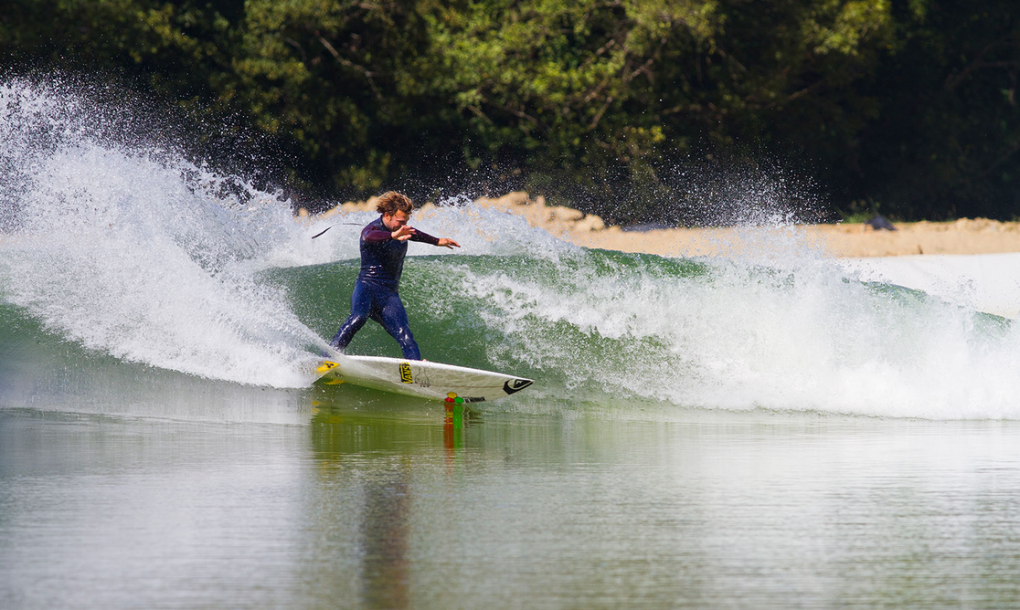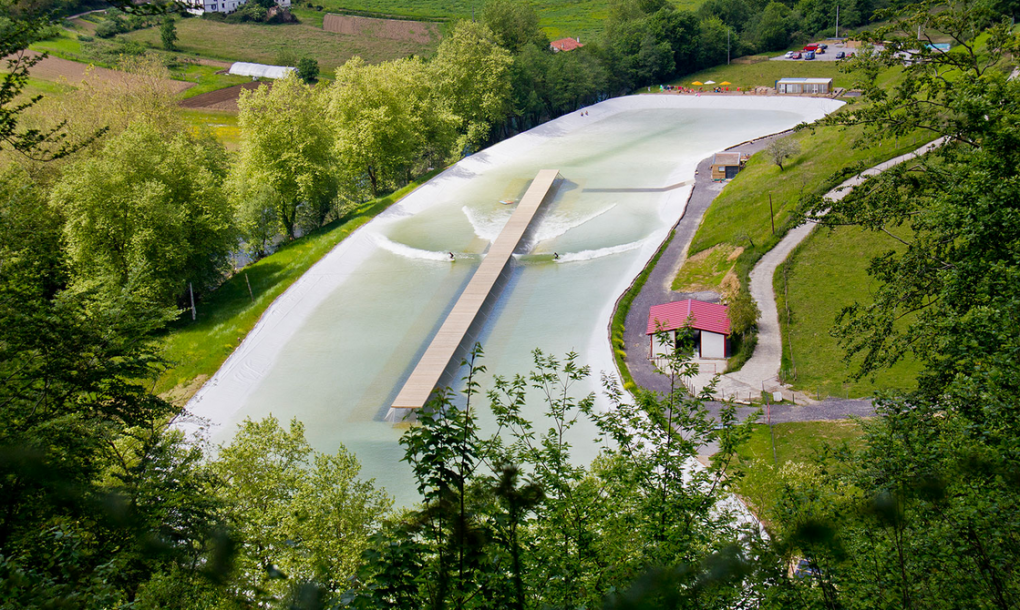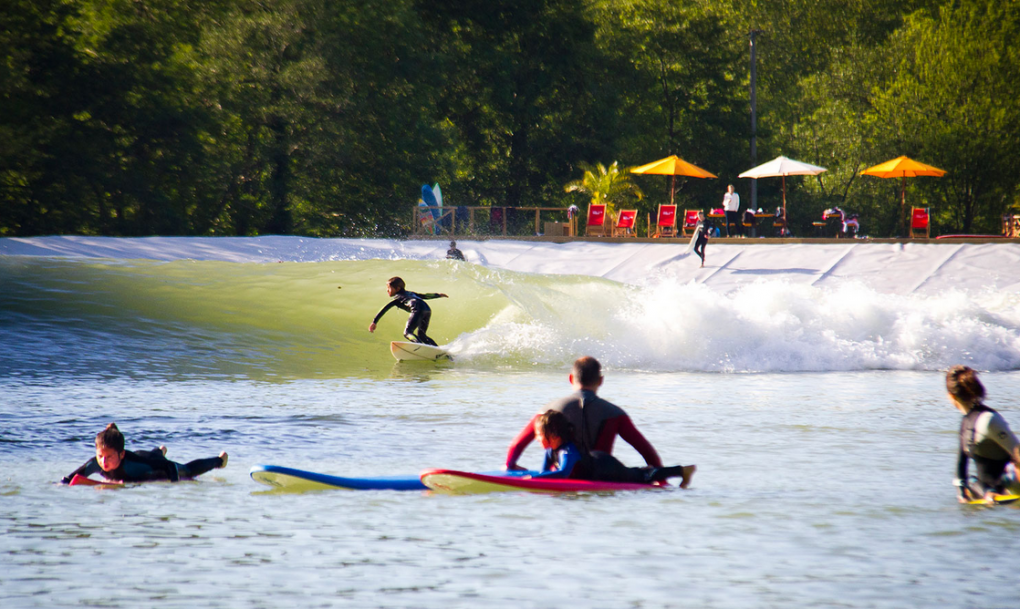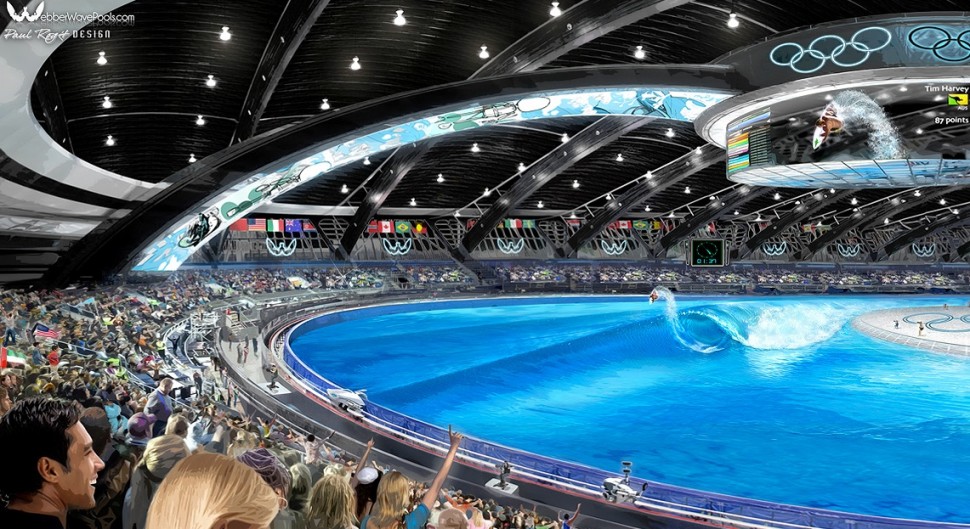
Malibu. The North Shore. Dolgarrog. A tiny village eight miles from the north Wales coast is the last place you’d expect to rank among cradles of surf culture.
Yet work has just begun on the world’s first commercial wave pool, Surf Snowdonia.
The International Surfing Association is calling it “a historic moment that will revolutionise our sport”. Sounds too crazy? We decided to investigate…
Make sure you also check out this amazing graphic showing all the nitty gritty bits about Surf Snowdonia.
So, who’s behind it?
Martin Ainscough, a serial entrepreneur who also owns the UK’s largest crane hire company.
Last year he heard about the Wavegarden, a prototype wave pool in north Spain, and decided it was just the job for a derelict aluminium smelting site he had bought near Conwy in Wales.
Having won over locals with the audacity of the £12m project as much as the promise of jobs, surfing’s first fun park is scheduled to open next summer.

“We’re not just producing a surfers’ paradise,” says Steve Davies, CAL’s managing director. “This will have quality restaurants, a coffee shop, an indoor children’s play building, a Total Wipeout-style pool and accommodation.”
Not all of the predicted 75,000 visitors a year will be surfers. Steve adds: “For the first time, people will be able to see surfers close-up. Now, the general public either see black dots on the horizon from the beach or see it on TV.
“Here, they will be able to sit with a coffee and watch a surfer actually go past from left to right. That must be good for bringing the sport to a much wider audience.”
How will it work?

Surf Snowdonia has bought Wavegarden technology wholesale. This uses a sort of hydraulic snowplough hauled through the water to generate a wave travelling in opposite directions on either side of a freshwater pool.
Surf Snowdonia is big. Really big. 300m by 113m big to be exact, equivalent to three football pitches long and two wide.
“The current Wavegarden is only 40m wide. Ours is nearly three times that. It’s a monster…”
Steve says: “The current Wavegarden is only 40m wide in total. Ours is nearly three times that. It’s a monster. There’s a lot of face to play with.”
Can the Wavegarden prototype upscale to that level? Well, as Steve points out, Surf Snowdonia is the first commercial showcase for Wavegarden – the Spanish team has a massive stake in ensuring good surf.
OK, but what about the waves?
The Surf Snowdonia wave will run for 180m and 18 seconds.
For public use, the wave will peel on either side of the pool in three marked zones: a 6ft wave (face) for advanced surfers, 4.5ft for intermediates and a 2-3ft wave at the far end for kooks.
By way of comparison, the Wavegarden waves you’ve seen online are 4.5ft.
On and offshore winds are irrelevant given the power of the artificial wave, Steve says (although the lake is orientated west-east across a north-south valley).
Won’t it be packed out?
Actually no. On each side of its pool, Surf Snowdonia will accommodate up to 20 beginners in the shallows and two intermediates trading chest-high waves, while one lucky surfer will enjoy a clean, head-high solo session. Bliss.

Given that waves will pulse through the pool every minute, you can expect to catch a wave every three minutes by the time you’ve ridden one and paddled back into the line-up.
Surfers will also be able to access instant replays of their waves to analyse mistakes and check out style.
And if that sounds bizarre consider this: you can book your waves online. No, really.
Is an artificial wave pool really surfing?
The million-dollar question. Certainly, artificial wave pools have their critics.
British big wave pro Andrew Cotton has argued that the key to being a surfer is being able to understand the ocean; learn to read the sea and you’ll catch more waves. No mechanical wave can teach that.
It was concerns about wave quality that led Surf Snowdonia to turn to GB surf team coach Lloyd Cole.
“You can book your waves online. No really…”
“We took him to the Wavegarden to see if this was going to upset the purists,” Steve says. “Within three waves he realised there was a slightly different technique, but he said that once you got it it was just incredible – he got a wave every minute.”
Certainly no one can who has seen YouTube videos of Gabriel Medina and Reubyn Ash spinning 360s and busting airs at Wavegarden can argue the wave sucks.
More interesting for us mere mortals is a comment by Britain’s Alan Stokes after he ripped up the Wavegarden. The wave pool guarantees the same perfect wave each time, he said; no sets, no wide-swinging waves, no tides to change shape.
“We’re not trying to replace Mother Nature,” Steve says, “but she can be frustrating. The key point about this for learning or practice is that if you get something wrong, you know there’s another wave coming along literally in a minute to put it right. On the sea you might wait half an hour for another wave and someone else might get it.”
Practice makes perfect. Or at least better. And that immediate video replay will let you see where you messed up.
What’s the future for wave pools?
For me, this is where the artificial wave concept becomes really interesting.
Surf Snowdonia could remain a playpark for beginners and holidaymakers. But it could just as easily take surfing in a whole new direction, generating a distinct style of riding with its own culture.

The mechanical consistency has also caught the attention of surfing’s world governing authority.
Fernando Aguerre, president of the International Surfing Association, explains: “This a historic moment that will revolutionise our sport. [With Surf Snowdonia}, we can host world-class surfing competitions with waves that are always consistent, powerful and publically available.
With the ability to make perfect waves every time, all the time, centres like Surf Snowdonia can help make surfing’s Olympic dream a reality.”
So could surfing be feature in a forthcoming Olympics? If head-high clean waves can peel in an inland Welsh village, nothing is impossible.